Lake Powell – Rainbow Bridge National Monument
Author: Tammy
As Scott wrote in his earlier post, we had an awesome time at Lake Powell. We were impressed at how big this lake is at 186 miles long!! The lake is the second largest man-made reservoir in the country (Lake Mead being the first). It was created by the flooding of Glen Canyon by the controversial Glen Canyon Dam, which also led to the creation of Glen Canyon National Recreation Area, spanning a 1932 square mile recreation area in southern Utah, and Northern Arizona.
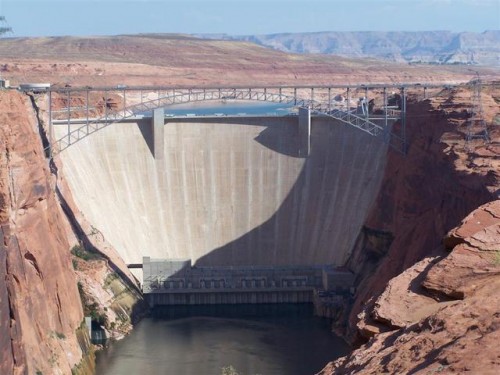
Glen Canyon Dam, a concrete structure rising 710 feet above the Colorado River, was completed in 1963. The dam provides essential water storage and power for much of the southwestern United States.
Rainbow Bridge National Monument, the largest natural bridge on earth, is the most famous site on Lake Powell. Each year hundreds of thousands of visitors come to admire this graceful stone arc, located about 50 water miles from Wahweap Marina and accessible by tour boats and private vessels. A courtesy dock is available for short-term docking while people make the 1 mile round trip walk to the bridge. Prior to the formation of Lake Powell, visiting Rainbow Bridge required a long 14 mile, rugged, waterless hike or horseback ride. You can still hike the original trail from abandoned Rainbow Lodge after acquiring a permit from the Navajo nation.
Rainbow Bridge is one of the seven natural wonders of the world and can be found in the canyon-lands of southeastern Utah. Rainbow Bridge stands at an impressive 290 feet tall and spanning 275 feet; the top of the bridge is 42 feet thick and 33 feet wide. Many references point out that the U.S. Capitol would fit beneath the span, about as long as a football field and it’s almost as tall as the Statue of Liberty.
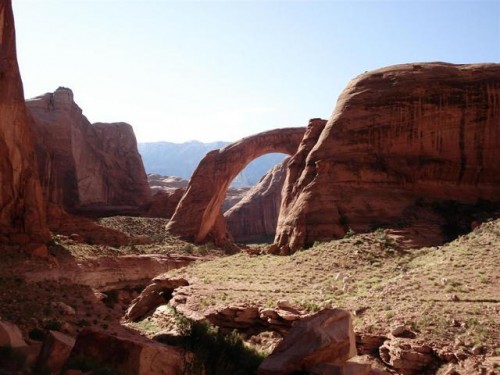
Rainbow Bridge is made of salmon-pink sandstone, with dark red and brown vertical streaks of iron ore. These particles, called “desert varnish,” may have leached from the rocks, or they may have been carried by the wind as dust that stuck to the moister areas of the rock. Subtle shades of purple and orange are brought out by the afternoon sunlight, turning the bridge into a rainbow of stone.
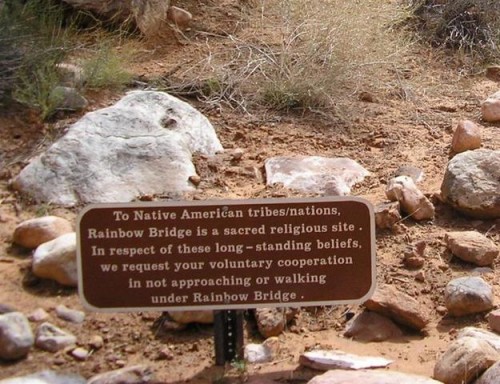
A Sacred Place
The region’s American Indians, including the San Juan Paiutes and White Mesa Paiutes, but especially the Navajos, consider Rainbow Bridge to be sacred and a place of worship. The Navajo believe rainbows represent the guardians of the universe. Seeing it and standing beneath it makes it easy to understand why the Native Americans hold the bridge as a sacred place — and why they fight so hard for its protection.
The Navajos named the bridge Nonnezoshe or “rainbow turned to stone.” Several Native American families still reside nearby.
There is an attempt by the National Park Service to preserve the sanctity of the bridge. That’s why swimming isn’t allowed, and commercial filming is closely monitored.
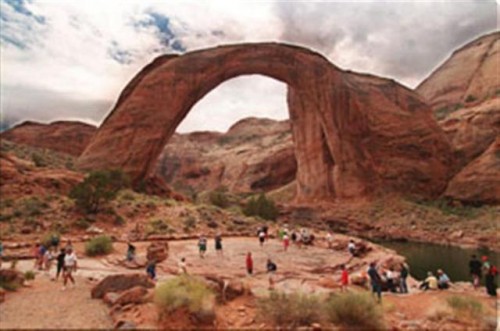
How Was Rainbow Bridge Formed?
The base of Rainbow Bridge was built by nature hundreds of millions of years ago, as layers of reddish-brown sands and muds, called Kayenta Sandstone, were deposited and compacted. The span of the bridge, composed of Navajo Sandstone, was formed as wave after wave of sand was deposited, forming dunes up to 1,000 feet high. Over the next 100 million years, the base and the dunes were buried under more than 5,000 feet of rock layers. The heat and immense pressure further compacted and hardened the rock of these formations.
Around 60 million years ago, the area now known as the Colorado Plateau began to uplift. Streams cut into and eroded the layers of rock as they lifted above sea level. As these massive layers rose and tilted, streams gained more momentum and force. Water flowing off Navajo Mountain formed Bridge Creek. As the creek meandered toward the Colorado River, it slowly eroded the sandstone, creating thin rock walls as it nearly looped back on itself. Rushing water during floods pounded away at the walls until the loosely cemented Navajo sandstone gave way, creating a hole. Over the centuries, as the creek flowed through the hole, it continued to work away at the sandstone until Rainbow Bridge was formed.
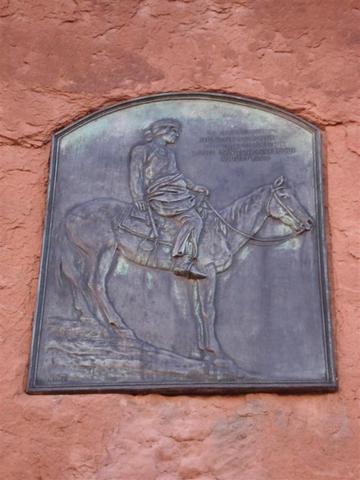
How Was Rainbow Bridge Discovered?
Rainbow Bridge was probably first seen by white people in the 1880s during a gold rush in Glen Canyon. Miners swarmed over the area seeking the precious metal and without a doubt ventured up the canyon. None of them, however, seemed compelled to share the news of this startling geologic oddity with the rest of the country.
Rainbow Bridge, brochures and Park Service studies note, was more permanently discovered on Aug. 14, 1909. Byron Cummings, dean of arts and sciences at the University of Utah, and W.B. Douglass, a government surveyor, had heard rumors of a great stone arch and set out from Kayenta, Ariz., at the same time, leading separate exploration parties. Eventually they combined forces and were led to the landmark by Jim Mike (then known as Mike’s Boy), a Paiute, and Nasja-Begay, variously described as a Paiute and a Navajo.
Mike — who lived over a century, passing away in 1977 — is now generally credited with finding the massive bridge in about 1900 while seeking pasture for a herd of horses.
Publicity following the Douglass-Cummings expedition gave Rainbow Bridge, tucked away in an obscure canyon below Navajo Mountain in the midst of the desolate Colorado Plateau, international renown.
President William Howard Taft proclaimed the wonder a national monument, setting aside a 160-acre tract on May 30, 1910.
If you ever have the chance to see this amazing natural wonder, I would definitely recommend it, because the same natural elements that made this beauty, could eventually destroy it if something ever happened to the dam holding back the Colorado River.
To see a lot more pictures from this awesome trip, click here!